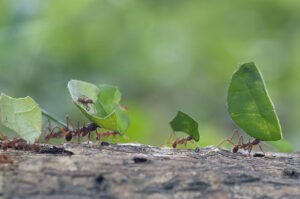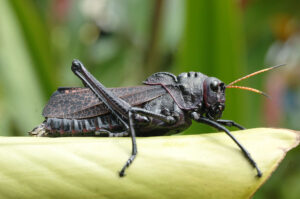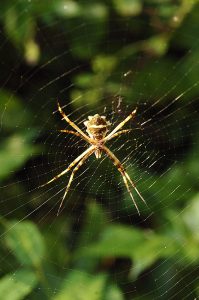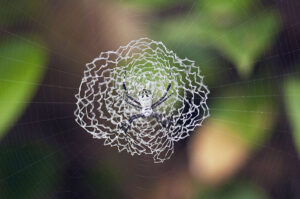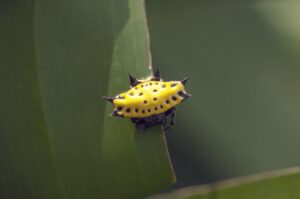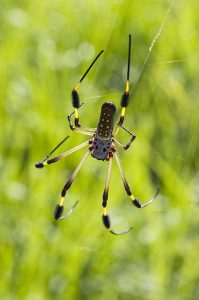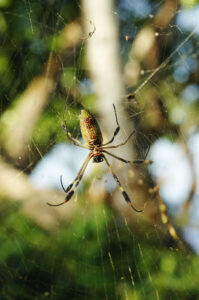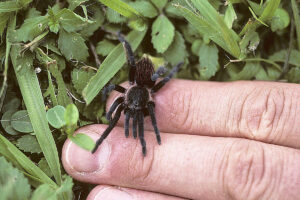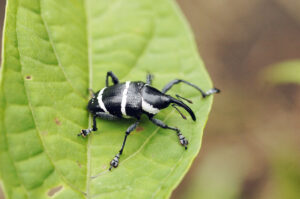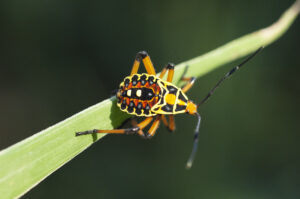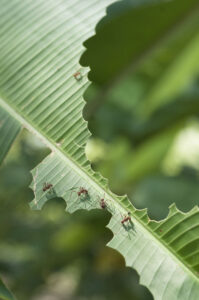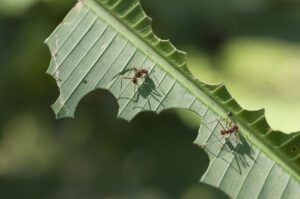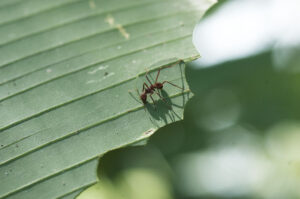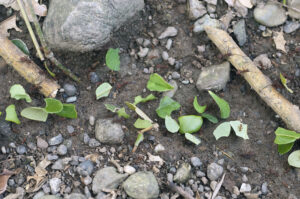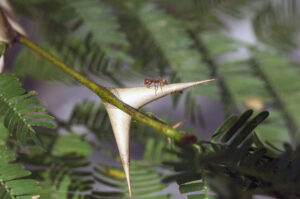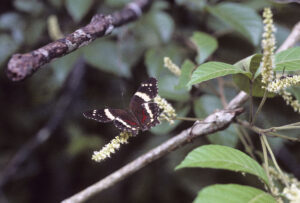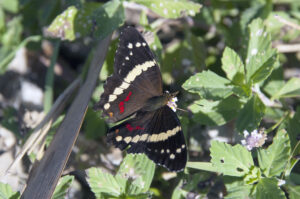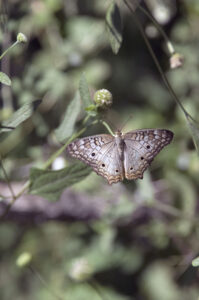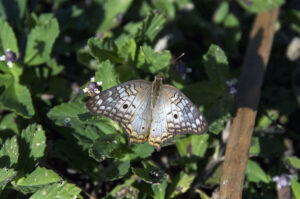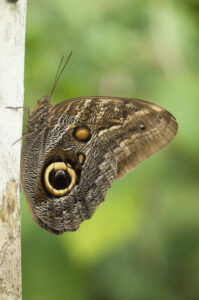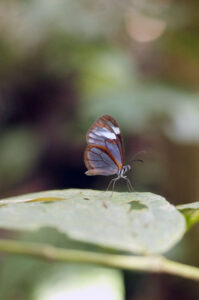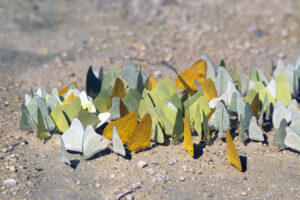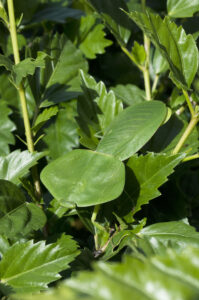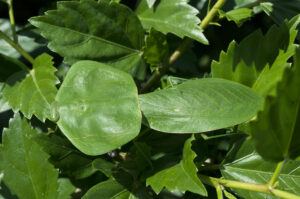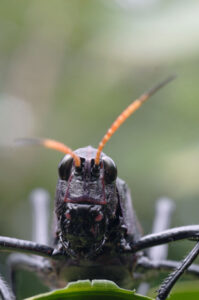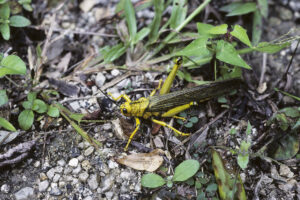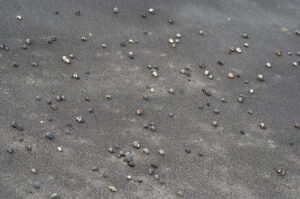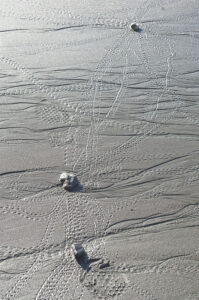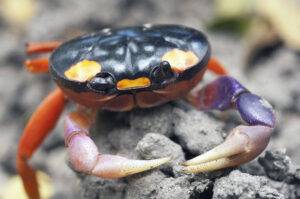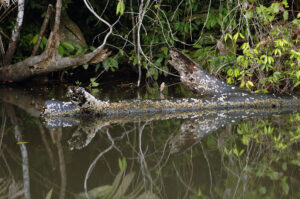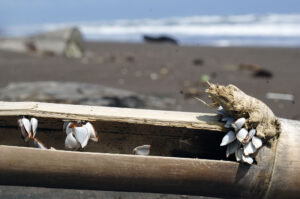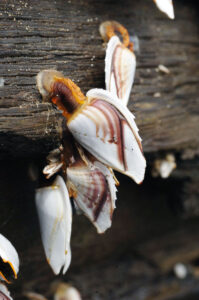Invertebrates in Costa Rica and Guatemala
This Argiope spider in Cahuita, Limón, Costa Rica, has caught a bush-cricket and is now entangling its prey in silk threads. (Photo copyright © by Kaj Halberg)
Leaf-cutter ants (Atta cephalotes), bringing leaf segments to their nest, holding them high as banners, Puerto Jiménez, Peninsula de Osa, Costa Rica. (Photo copyright © by Kaj Halberg)
Taeniopoda reticulata, a large grasshopper, Tortuguero National Park, Limón, Costa Rica. (Photo copyright © by Kaj Halberg)
This page deals with a selection of animals, which I encountered during a 7 week long stay in Guatemala October-December 1998, and a one month long stay in Costa Rica January-February 2012. They are divided into sections on spiders, insects, and crustaceans. Within each group, families, genera, and species are presented in alphabetical order.
A number of pictures, depicting unidentified species, are also shown. If you are able to identify any of these animals, or if you find any errors, I would be grateful to receive an email. You may use the address at the bottom of this page.
Spiders
Araneidae Araneid spiders
This cosmopolitan family, comprising more than 3,000 species, is well-known to most people, as many of these spiders are quite colourful, and their webs are often found in gardens and along roads. Initially, araneid spiders make a framework of non-sticky threads, before adding final spirals of threads, covered in sticky drops.
These spiders are also called orb-weavers, from the old English word orb, meaning ‘ball-shaped’ or ‘circular’, in this case referring to the circular webs, which are suspended among vegetation, in fences, and other places.
Argiope
Members of this genus of araneid spiders, comprising about 90 species, are distributed in all warmer areas of the world. Their web is quite large and often rather invisible, with the exception of a pure white silk pattern in the centre, made from densely woven threads, which form an X or a zig-zag pattern.
The spider sits with one pair of legs in each of the four directions of the X, or aligned with the zig-zag pattern. This often makes the animal extremely visible, and many scientists have speculated as to what purpose this pattern is made. One theory is that its visibility might prevent large animals from accidentally destroying the web. Research has also shown that the pattern reflects ultra-violet light, which may attract prey to the web.
Argiope, Cahuita, Limón, Costa Rica. (Photo copyright © by Kaj Halberg)
This Argiope is sitting in its web, its legs aligned with the X-shaped figure, Cahuita. (Photo copyright © by Kaj Halberg)
The pattern of silk threads in the web of this small Argiope is indeed conspicuous, but the spider itself is well camouflaged. – Reserva Nacional Hacienda Baru, Costa Rica. (Photo copyright © by Kaj Halberg)
Gasteracantha Spiny-backed orb-weavers
A genus of at least 60 species of araneid spiders, distributed worldwide in warmer areas. They have a very short life span, only a few months. Females die after laying eggs, males a few days after depositing sperm in the female.
The generic name is derived from the Greek gaster (‘belly’) and acantha (‘thorn’), referring to a number of spines, usually 6, protruding from the abdomen. These spines, as well as a shield-like carapace, covering almost the entire animal, are means of defense against enemies.
Gasteracantha cancriformis
This species is widespread, found from southern United States southwards through Central America and the Caribbean to central South America. It lives in rather open areas, including forest edges and gardens.
The colour of this animal varies tremendously, the shield being red, yellow, white, or black, the spines black or red. Females grow to 1 cm long and 1.3 cm wide, whereas males are very small, only to 3 mm long. The female has pointed spines, whereas those of the male are stubby.
The specific name is derived from the Latin cancer (‘crab’) and forma (‘shape’), alluding to the crab-like shield.
Female Gasteracantha cancriformis, Puerto Jiménez, Peninsula de Osa, Costa Rica. (Photo copyright © by Kaj Halberg)
Nephila Golden orb-weavers
This striking genus of araneid spiders, comprising about 23 species, is found in tropical and subtropical regions around the world. The female, which is many times larger than the male, can grow to 6 cm in body length, with a leg span up to 15 cm.
The generic name is derived from the Greek nein (‘to spin’) and philos (‘love’), thus ‘fond of spinning’. The web of these spiders is enormous, up to 2 m across, with supporting strands much longer. The webs of different females are sometimes inter-connected, together covering many square metres. Small birds and bats are reported to have been caught in these strong webs.
Nephila clavipes American golden orb-weaver
This species is found in a huge area, from the United States southwards to southern South America.
Dorsal view of a female American golden orb-weaver, Reserva Nacional Hacienda Baru, Costa Rica. (Photo copyright © by Kaj Halberg)
Ventral view of a female, Cahuita, Limón, Costa Rica. (Photo copyright © by Kaj Halberg)
Theraphosidae Tarantulas
A huge group of large and often hairy spiders with 156 genera and more than 1,000 species. They are found on all continents, except Antarctica.
The common name originally stems from Lycosa tarantula, a hairy species of wolf spider from southern Europe. The name refers to the Italian town of Taranto. Presumably, the type specimen was collected there. Later, the term tarantula was applied to many large, ground-living spiders, especially those of the family Theraphosidae.
Tliltocatl
A small genus of 7 species, native to Mexico and Central America. They were previously placed in the genus Brachypelma.
Habitat destruction and collection for the pet trade has led to these two genera to be protected according to the rules of CITES (Convention on International Trade of Endangered Species).
The generic name is derived from Nahuatl tlil (‘black’) and tocatl (‘spider’).
Tliltocatl sabulosus
This species, previously known as Brachypelma sabulosum, is restricted to Guatemala. Its colour is predominantly black, with reddish or brownish hairs on the abdomen. Females attain a length of up to 7 cm, whereas the males are smaller.
The specific name is derived from the Latin sabulo (‘coarse sand’ or ‘gravel’), thus ‘living in gravel’.
Tliltocatl sabulosus, Tikal National Park, Guatemala. (Photo copyright © by Kaj Halberg)
Insects
Coleoptera Beetles
With about 400,000 species, this is the largest of all orders, constituting almost 40% of described insects, and about 25% of all known animals. Beetles are found all over the world, except in the polar regions. New species are discovered frequently.
Curculionidae True weevils, snout beetles
One of the largest animal families on the planet, with about 6,800 genera and at least 83,000 species.
Weevil, Chato Volcano, Volcán Arenal National Park, Cordillera de Tilarán, Costa Rica. (Photo copyright © by Kaj Halberg)
Hemiptera True bugs
Bugs of this order are called ‘true bugs’ to distinguish them from other groups of insects – and some arthropods, for that matter – which people often refer to as ‘bugs’.
True bugs are a very large group of insects, with more than 80,000 species, comprising many superfamilies, including shield bugs (Pentatomoidea), red bugs or cotton stainers (Pyrrhocoroidea), cicadas (Cicadoidea), planthoppers (Fulgoroidea), and aphids (Aphidoidea).
True bugs are very diverse, but have one thing in common, namely piercing mouthparts with which they suck juice from plants or, in some cases, from other animals. Their mouthparts are contained in a beak, a so-called rostrum, which is usually held underneath the body when not in use. True bugs are often found in large congregations, densely clustered on stones, walls, or elsewhere.
Pyrrhocoridae Red bugs, fire bugs
This family of colourful bugs contains more than 300 species worldwide.
Dysdercus
A widespread genus with about 70 species, distributed in tropical areas around the world. A number of species feed on cotton plants, leaving a yellow-brownish stain on the lint, which is impossible to wash off. For this reason, these species are called ‘cotton stainers’.
Dysdercus concinnus Pale red bug, Turk’s cap bug
This animal is found from extreme southern United States southwards to northern South America. It often feeds on Turk’s cap (Malvaviscus arboreus), which gave rise to one of its common names.
The specific name is Latin, meaning ‘pretty’ or ‘pleasing’.
Pale red bug, Palo Verde National Park, Guanacaste, Costa Rica. (Photo copyright © by Kaj Halberg)
Unidentified true bug, Reserva Nacional Hacienda Baru, Costa Rica. (Foto copyright © by Kaj Halberg)
Hymenoptera Bees, wasps, ants, and allies
A large order with more than 150,000 species, comprising wasps, bees, sawflies, and ants.
Formicidae Ants
A huge worldwide family with an estimated 22,000 species.
The family name is derived from formica, the Latin name of these animals.
Atta Leaf-cutter ants
This genus contains at least 17 species, distributed from southern United States southwards to Paraguay and northern Argentina.
These ants are unique, as they cut small leaf segments with their sharp mandibles and then carry them to their underground nest, holding them high as banners.
In the nest, they have ‘gardens’ where they grow a fungus of the family Lepiotaceae. The fresh vegetation is used as nutrition for this fungus, and the ants remove mold and parasites from the fungus. Bacteria growing on the ants secrete chemicals, which act as pesticides. The ants are able to detect if a particular type of leaf is toxic to the fungus, and in that case they will no longer collect it.
The fungus is used as food for the ant larvae, whereas adult ants feed on leaf sap. The larvae need the fungus to stay alive, and the fungus needs the ants to stay alive – a perfect example of symbiosis.
The nest, which can be as deep as 7 m, is placed in a way that allows a breeze to remove dangerous carbon dioxide emitted by the fungus. (Source: en.wikipedia.org/wiki/Leafcutter_ant, where a list of references is given)
The generic name is Latin and may be translated as ‘one who walks upon the tips of his toes’.
Atta cephalotes
A widely distributed species, found from Mexico southwards to Bolivia and north-eastern Brazil.
The specific name is derived from Ancient Greek kephale (‘head’), thus ‘having a (large) head’.
Atta cephalotes, cutting leaf segments and bringing them to their nest, holding them high as banners, Puerto Jiménez, Peninsula de Osa, Costa Rica. (Photos copyright © by Kaj Halberg)
Pseudomyrmex Acacia ants
These arboreal, wasp-like ants, counting about 155 species, are widely distributed in warm areas, found from southern United States southwards to Chile and Argentina.
A number of species live in symbiosis with various species of acacia (Vachellia). The ants attack creatures of all sizes attracted by the acacia leaves, killing insects and stinging the heads of browsing mammals. Even epiphytic plants are destroyed. The ants also clear the ground around the tree of seedlings. In return, the ants live inside swellings on the tree, protected from enemies.
The generic name is derived from Ancient Greek pseudes (‘false’) and myrmex (‘ant’).
Pseudomyrmex ferruginea
This orange-brown ant, to 3 mm long, is distributed from central Mexico southwards through Central America to Columbia. It lives in symbiosis with the bullhorn acacia (Vachellia collinsii).
The specific name is Latin, meaning ‘rust-coloured’, derived from ferrum (‘iron’).
Pseudomyrmex ferruginea on thorns of bullhorn acacia, Palo Verde National Park, Guanacaste, Costa Rica. (Photos copyright © by Kaj Halberg)
Vespidae Social wasps
This family includes the best-known wasps, including yellowjackets and hornets, which live in communal nests, centered around an egg-laying queen, and with many sterile workers.
The majority of other wasps are solitary, with each female building its own nest, or digging cavities in the ground, in which it places insects that it has stunned with its stinger, and then laying eggs on them.
Polistes Paper wasps, umbrella wasps
A very large cosmopolitan genus, counting at least 220 species. The common name umbrella wasps refer to the shape of the nest of many of the species.
The generic name is Ancient Greek, meaning ‘founder of a city’.
Polistes carnifex Executioner wasp
The name of this very large, yellow and brown paper wasp is Latin, meaning ‘executioner’, ‘hangman’, ‘tormentor’, or ‘murderer’, originally from carnis (‘meat’), combined with the suffix fex (‘maker’), thus ‘flesh-maker’ (butcher). The name alludes to the painful sting of this species.
It is widely distributed, found from southern United States southwards to northern Argentina. It lives in small colonies, founded by queens, which build nests under the eaves of buildings or hanging from branches.
Executioner wasp, Palo Verde National Park, Guanacaste, Costa Rica. (Photo copyright © by Kaj Halberg)
Lepidoptera Butterflies and moths
About 126 families and 180,000 species of this order have been described. The name means ‘scaly wing’, derived from Ancient Greek lepis (‘scale’) and pteron (‘wing’).
Contrary to the popular belief that butterflies and moths are two separate groups, genetic research has shown that butterflies are simply relatively recently derived, colourful, day-flying moths, comprising the superfamilies Hesperioidea (skippers) and Papilionoidea, the latter consisting of the families Lycaenidae (gossamer-winged butterflies, blues, coppers), Nymphalidae (brush-footed butterflies), Papilionidae (swallowtails and birdwings), Pieridae (whites, sulphers, and orange-tips), and Riodinidae (metalmark butterflies).
Nymphalidae Brush-footed butterflies
Comprising more than 6,000 species, this is the largest butterfly family, distributed on all continents, except Antarctica. Today, this family includes a number of subfamilies, which were previously treated as separate families, including Heliconiinae, Danainae, and Satyrinae.
The name brush-footed butterflies refers to a brush-like set of hairs on the forelegs of a number of species. Another common name is four-footed butterflies, as many members are known to stand on only four legs. The forelegs are reduced and often curled up.
Anartia New World peacocks
A small genus of 5 species, found in southern United States, the Caribbean, Mexico, Central America, and most of South America.
In his book Catalogus etymologicus Coleopterorum et Lepidopterorum (R. Friedland & Sohn, Berlin, 1887), L. Glaser states that Anartia is a “prince of the caste of the children of the sun” in Indian mythology.
Anartia fatima Banded peacock
A common species, distributed from southern Texas southwards through Mexico and Central America to Panama. It is found in open habitats and second-growth woodlands, often observed near rivers.
Fatima is a name of Arabic origin, meaning ‘the shining one’. It was the name of the Prophet Muhammad’s daughter, and for this reason many Muslims call their daughter Fatima.
Banded peacock, Tikal National Park, Guatemala. (Photo copyright © by Kaj Halberg)
Banded peacock, Palo Verde National Park, Guanacaste, Costa Rica. (Photo copyright © by Kaj Halberg)
Anartia jatrophae White peacock
This common butterfly, comprising 7 subspecies, is found in Florida, the Caribbean, Mexico, Central America, and South America, southwards to Argentina.
The specific name is Latin, meaning ‘of Jatropha’. However, the larvae of this species have never been observed eating from plants of the genus Jatropha. A sentence in the description of the type specimen was “Habitat in Jatropha Americes.” This may refer to an unidentified locality.
White peacock, Palo Verde National Park, Guanacaste, Costa Rica. The animal in the upper picture is feeding in Melanthera flowers. (Photos copyright © by Kaj Halberg)
Caligo Owl butterflies
A genus with about 22 species of very large butterflies, the largest with a wingspan up to 20 cm. They are found in various forest types, from Mexico southwards to Brazil.
The generic name is Latin, meaning ‘darkness’, alluding to the fact that these butterflies mainly fly at dusk. The common name refers to the large ‘eye’ spots on the underside of the wing, which resemble owls’ eyes.
Caligo illioneus
This species has a wingspan up to about 15 cm. It is native from Costa Rica eastwards to Guayana and north-eastern Brazil, and in western South America southwards to Bolivia and Paraguay. It also occurs on Trinidad.
The specific name refers to a character in the Greek mythology, where there are at least four persons with the name Ilionesus. According to one source, it alludes to a companion of the Trojan hero Aeneas, who was first mentioned in Homer’s Iliad. Ilionesus was one of the survivors, when the ships of Aeneas and his people were caught in a terrible storm. He led the survivors to Italy, where they founded Rome.
Caligo illioneus, Reserva Nacional Hacienda Baru, Costa Rica. (Photo copyright © by Kaj Halberg)
Greta Clearwing butterflies
A genus of about 25 species, found from Mexico and the Caribbean southwards to the major part of South America.
The generic name is short for the name Margareta, which is derived from Ancient Greek margarites (‘pearl’), alluding to the pearl-white markings on the wings of several species.
Greta oto Glasswing butterfly
This spectacular butterfly has transparent wings, an adaptation to camouflage. In Spanish, it is called espejitos (‘little mirrors’), referring to the wings. Its usual area of distribution is from southern Mexico southwards to central Brazil. However, it is known to stray long distances and has been observed as far north as Texas and as far south as Chile.
The specific name is Ancient Greek, derived from ous (‘ear’). What it refers to is not clear.
Glasswing butterfly, Volcán Arenal National Park, Cordillera de Tilarán, Costa Rica. (Photo copyright © by Kaj Halberg)
Heliconius Longwings
A genus with about 30 species, ranging from extreme southern United States southwards to northern Argentina.
The generic name is derived from Ancient Greek helix (‘spiral’), alluding to the tongue of these butterflies being coiled in a spiral. This name is a bit odd, as the tongue of most butterflies is rolled up in a spiral, when the animal is not feeding.
Heliconius erato Crimson-patched longwing
Divided into at least 28 subspecies, this pretty butterfly is found in a vast area, from extreme southern United States southwards to northern Argentina. Host plants include a large number of passion flower vines (Passiflora).
Due to its very bad taste, it is relatively safe from predators, but is occasionally eaten by birds, lizards, monkeys, and mantids.
The specific name refers to one of the Greek muses, who presided over lyric poetry. The name means ‘lovely’ or ‘charming’, derived from erastos ‘beloved’.
Crimson-patched longwing, Tikal National Park, Guatemala. (Photo copyright © by Kaj Halberg)
Pieridae Whites, sulphurs, orange-tips
This large family, comprising about 76 genera and 1,100 species, is distributed almost worldwide, with the highest concentration in tropical areas of Africa and Asia. The pigments that give the characteristic colour of these butterflies are derived from waste products in their body.
Several species of whites, sucking moisture from soil, Tikal National Park, Guatemala. (Photo copyright © by Kaj Halberg)
Mantodea Praying mantises
This order contains about 30 families with c. 430 genera and more than 2,400 species. These animals are distributed worldwide in warmer temperate, subtropical, and tropical regions, living in a variety of habitats.
They are carnivorous insects that will wait in ambush in the vegetation for an insect or another small invertebrate to pass by. With lightening speed, the mantis throws its forelegs forward and snatches the unfortunate victim, which is then devoured by the mantis. Sometimes a female will even eat the male, after he has inserted his semen in her.
These insects got their name from their posture, with the forelegs ‘folded’, as if they were in prayer – quite contradictory to the real purpose of this posture!
Mantidae
A very large family with 10 subfamilies and about 75 genera, distributed in all warmer regions of the world.
Choeradodis Shield mantises, leaf matises
Shaped like a leaf, these praying mantises are very well camouflaged, when they sit among leaves, waiting for prey to pass by. They move slowly back and forth, mimicking a leaf moving in the wind.
Comprising 5 species, they are found from Mexico southwards to Peru and Brazil.
Choeradodis rhombicollis
This species occurs from Mexico eastwards to Cayenne, southwards to Peru.
The specific name is derived from the Latin rhombus (‘diamond-shaped’) and collis (‘hill’), alluding to the slightly arched shield.
Choeradodis rhombicollis, El Castillo, Cordillera de Tilarán, Costa Rica. (Photos copyright © by Kaj Halberg)
Orthoptera Grasshoppers and allies
The order Orthoptera is divided into to suborders, Caelifera (grasshoppers) and Ensifera (crickets, katydids, and others). Both groups are characterized by mouthparts adapted for biting and chewing, hind legs modified for jumping, and organs to produce their characteristic sounds. Ensiferans have much longer, threadlike antennae than the grasshoppers, often longer than their bodies.
These animals are plant-eaters, and some species at times become serious pests, forming huge swarms that consume crops over wide areas. Most species protect themselves from predators by camouflage. If detected, they suddenly jump into the air, many species displaying brilliantly coloured wings to startle the predator. Other species have strong colours as a warning to predators that they are ill-tasting.
Romaleidae Lubber grasshoppers
This family, comprising two subfamilies with at least 56 genera, is widespread in the Americas.
Taeniopoda
A genus with at least 12 species, occurring from extreme southern United States southwards to Panama.
The generic name is derived from Ancient Greek tainia (‘band’ or ‘ribbon’) and pous (‘foot’), thus ‘with ribbon-like feet’.
Taeniopoda reticulata
This large species is distributed from southern Mexico eastwards to Panama.
The specific name is derived from the Latin reticulum (‘small net’) and the adjective-forming suffix atus, thus ‘net-like’, alluding to the pattern on the wings.
Taeniopoda reticulata, Tortuguero National Park, Limón, Costa Rica. (Photos copyright © by Kaj Halberg)
Unidentified grasshopper, Tikal National Park, Guatemala. (Photo copyright © by Kaj Halberg)
Crustaceans
A huge, diverse group of arthropods, which includes crabs, shrimps, fish lice, krill, barnacles, copepods, and many others, comprising altogether at least 67,000 species.
Anomura Hermit crabs and allies
Paguridae Hermit crabs
This large family, containing about 80 genera with more than 540 species, occurs worldwide in warmer regions.
The family name is derived from Ancient Greek pagouros (‘crab’). The common name alludes to these animals hiding their soft abdomens inside protective sea shells, which come in all sorts of shapes – round, oblong, spiraled. Snail shells are mostly used, and when the hermit crab grows too big for its shell, it must find a larger, suitable shell and make the change rapidly to avoid revealing its soft, vulnerable abdomen for too long.
This beach, called Naranjo, is alive with hermit crabs of all sizes, Santa Rosa National Park, Guanacaste, Costa Rica. (Photos copyright © by Kaj Halberg)
Judging from their tracks, which create fine patterns in the sand, hermit crabs seem to prefer feeding around pebbles, Corcovado National Park, Costa Rica. (Photo copyright © by Kaj Halberg)
Brachyura True crabs
Gecarcinidae Land crabs
This family contains 7 genera with about 28 species, found across the globe in warmer regions, with the largest diversity in the Pacific.
Gecarcinus
A small genus of 4 species of colourful crabs, found from extreme southern United States southwards to Peru, and also in the Caribbean and on the Bahamas.
The generic name is derived from Ancient Greek geo (‘earth’ or ‘land’) and karkinos (‘crab’).
Gecarcinus quadratus Harlequin land crab
This animal, reaching a length of up to 5 cm, lives in mangrove, rainforests, and sand dunes along the Pacific coast, from Mexico eastwards to Panama.
Previously, it was thought that animals on the Pacific coast of north-western South America also belonged to this species, but this population is now regarded as a separate species, G. nobili.
Harlequin land crab, Santa Rosa National Park, Guanacaste, Costa Rica. (Photo copyright © by Kaj Halberg)
Cirripedia Barnacles
These crustaceans, comprising 11 orders with more than 1,000 species, are found in all seas around the globe.
This tree trunk, which has drifted into riparian forest along the Tortuguero River, Limón, Costa Rica, is covered in barnacles. (Photo copyright © by Kaj Halberg)
Goose barnacles on a bamboo stem (top), and on a tree trunk, both washed ashore in Tortuguero National Park, Limón, Costa Rica. (Photos copyright © by Kaj Halberg)
(Uploaded September 2023)

